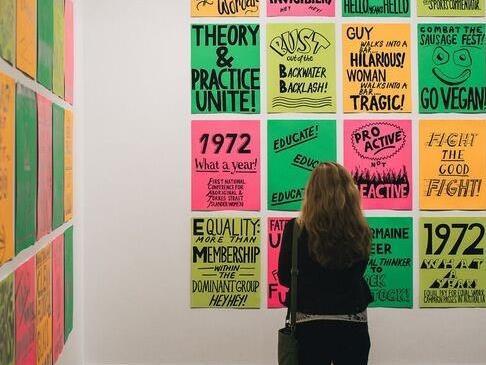Things I Learnt About Feminism by Kelly Doley at UWA’s Lawrence Wilson Gallery.
Things I Learnt About Feminism #1- #95 (Ink Pen on 220gm fluorescent card. 60-52cm, 95 pieces, 2014) by Melbourne based artist Kelly Doley is a new acquisition for the Cruthers Collection of Women’s Art in WA which is the only public collection focused specifically on women’s art in Australia. The work is made up of 95 bold, fluorescent and slightly retro posters – each with a different visual message. The different fonts and graphics work at making these posters pictorial. It captures your attention hanging in the gallery to the right off the main entrance as you walk into the Lawrence Wilson Gallery at the University of Western Australia. The green, pink, yellow and orange hand printed Indian ink on cardboard posters compete and jostle for your attention as they sprawl over the two walls. There’s an almost scrappy quality to this DIY look and you can easily imagine these posters being held up at a protest rally with their bold colours fixing your attention as perhaps Doley intends in terms of re-prioritising feminism as a debate. Doley’s primary medium is the research itself as Curator Gemma Weston writes which means exploring the ‘auto-ethnography of a self-aware anthropologist’ and positions Doley as an eternal student rather than an expert. For instance, UN research suggests it will take 95 years to reach gender parity; hence the 95 posters.
The exhibition takes its name from the process Doley carried out with a group of 16 people stemming from the original The Learning Centre: Two Feminists in 2012 whereby she swapped her portraits of the participants (including the now more well-known Clementine Ford) for their knowledge/comments about feminism which she has transformed into these posters. Their learnings got obliquely distilled into slogans, aphorisms and graphics ultimately reflecting a broad spectrum of priorities and perspectives. Doley also works with the Brown Council (BC Institute) a group of four artists that explore women’s representation in art history and primarily work in performance art, with Doley’s focus on performance and the live encounter. Weston discusses the role of this work as a still current reflection of the increased zeitgeist of interest in feminism, following on from events such as Julia Gillard’s misogynist speech and Jill Meagher’s very public tragic abduction and murder in 2012 when the work was made. However Weston makes the point that this work is also a partial archive.
As your vision re-focuses from the bright colours you engage with the individual messages written on each poster – ‘Yes means Yes. No means No. Maybe means Maybe. Hello means Hello’, and ‘Mary Wollstonecraft fighting the good fight since 1790’. In what often seems to be an anti-feminist world despite the younger public generation of Emma Watson and Lena Dunham voices, this work feels quite deliberately sloganistic and a challenge to complacency.
The work also captures a certain nostalgia in being a ‘retro’ physical object versus online communication (that also forms a background conversation to this work) that represents a different type of community than that sometimes experienced online. As Clementine Ford has recently spoken about the loud, agitated voices that are activated every time an online conversation causes reactivity, this work moves into a ‘quieter’ conversation that does not require online interaction – posters speak for themselves and can pose contradictory voices for us to spend time dwelling on.
Things I Learnt About Feminism as a collection of print media/works on paper speaks to the other paper based/screen print works in The Cruthers Collection which has been based at UWA for nearly ten years and now has 600 works. The Cruthers family started collecting in the 1970’s and bequeathed a set of 400 works to UWA in 2007. Portraiture, abstraction and print making are all part of the Collection’s focus as well as ensuring that the ongoing diverse experiences of women are reflected in acquired new works.
Doley retains the intellectual property of the posters so the life of the project continues with prints and t-shirts of the slogans. As discussions continue around the extreme polarisation of the USA Presidential race and the positions of power that women may or may not be ‘allowed’, it feels necessary to have more public discussion of the way feminism is embodied by us all – men and women, black and white, young and old. Doley by positioning herself as ‘discovering’ along with her audience embraces the zeitgeist of not being an ‘expert’ which makes the work appealing to a broader audience but also means the work feels somewhat unfinished. It also allows one to question the involvement of certain participants over others, where many of the slogans may feel unrelated-able to particular viewers. The different levels of volume may contradict each other i.e. ‘Feminism by stealth’ next to ‘The time for Feminism by stealth is over’ placed next to ‘Second wave feminism – it’s a white middleclass thing’. Some of the posters are more engaging with their use of image, for instance ‘Reclaim the Gaze’ with multiple profile views of a person’s face reverberating through the poster; ‘What do we want?’ More (dinner plate with meal) than the dinner party’; ‘Julie Gillard ….the perfect TARGET’ on yellow fluoro with a target set in the middle of the text. These perspectives collide against each other and in this way speak to a conversation than may not be as strident in other circumstances.
Rating: 3 1/2 stars out of 5
Things I Learnt About Feminism by Kelly Doley
Lawrence Wilson Gallery, UWA, Perth 10am-5pm
7 October – 10 December 2016





